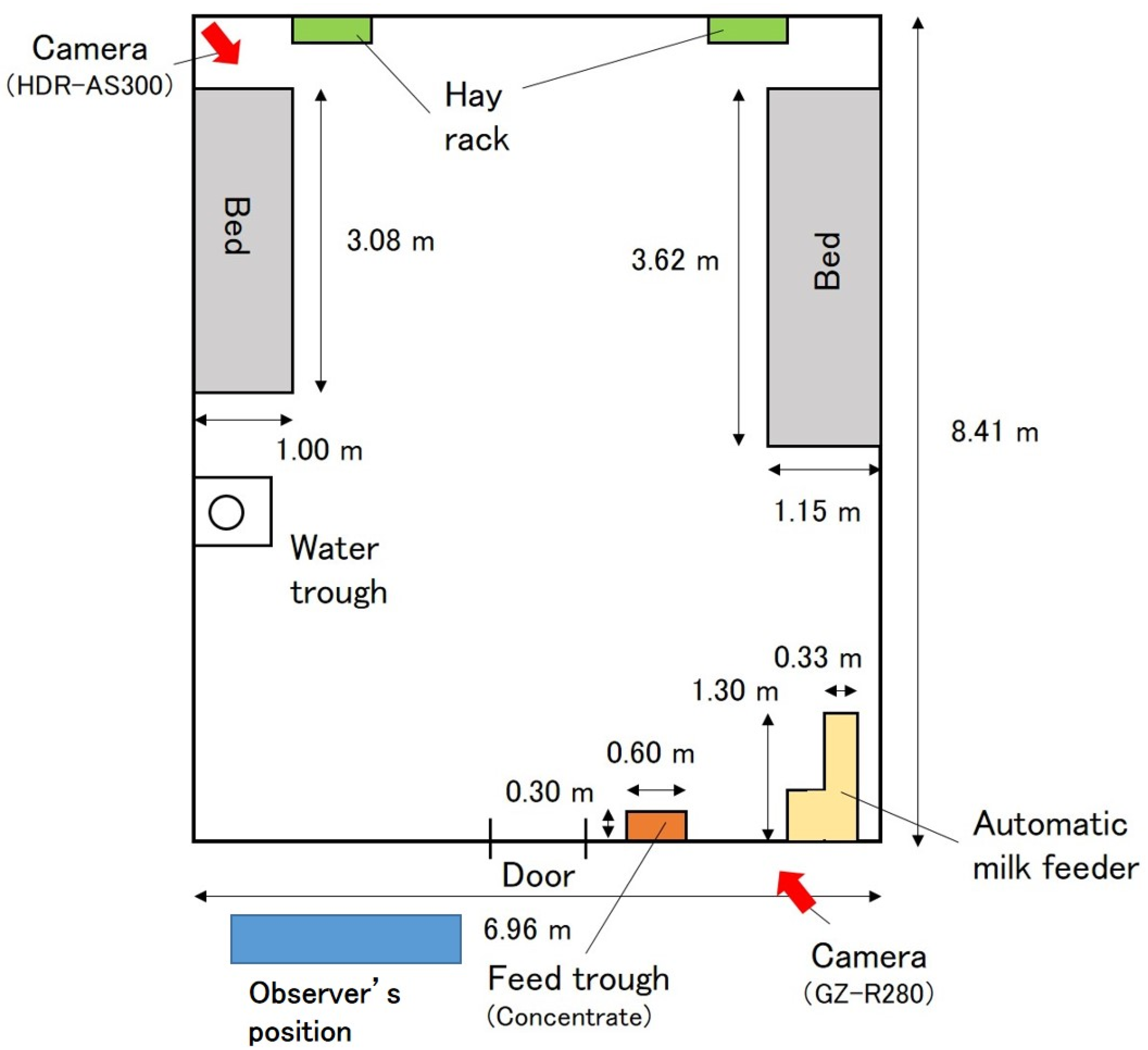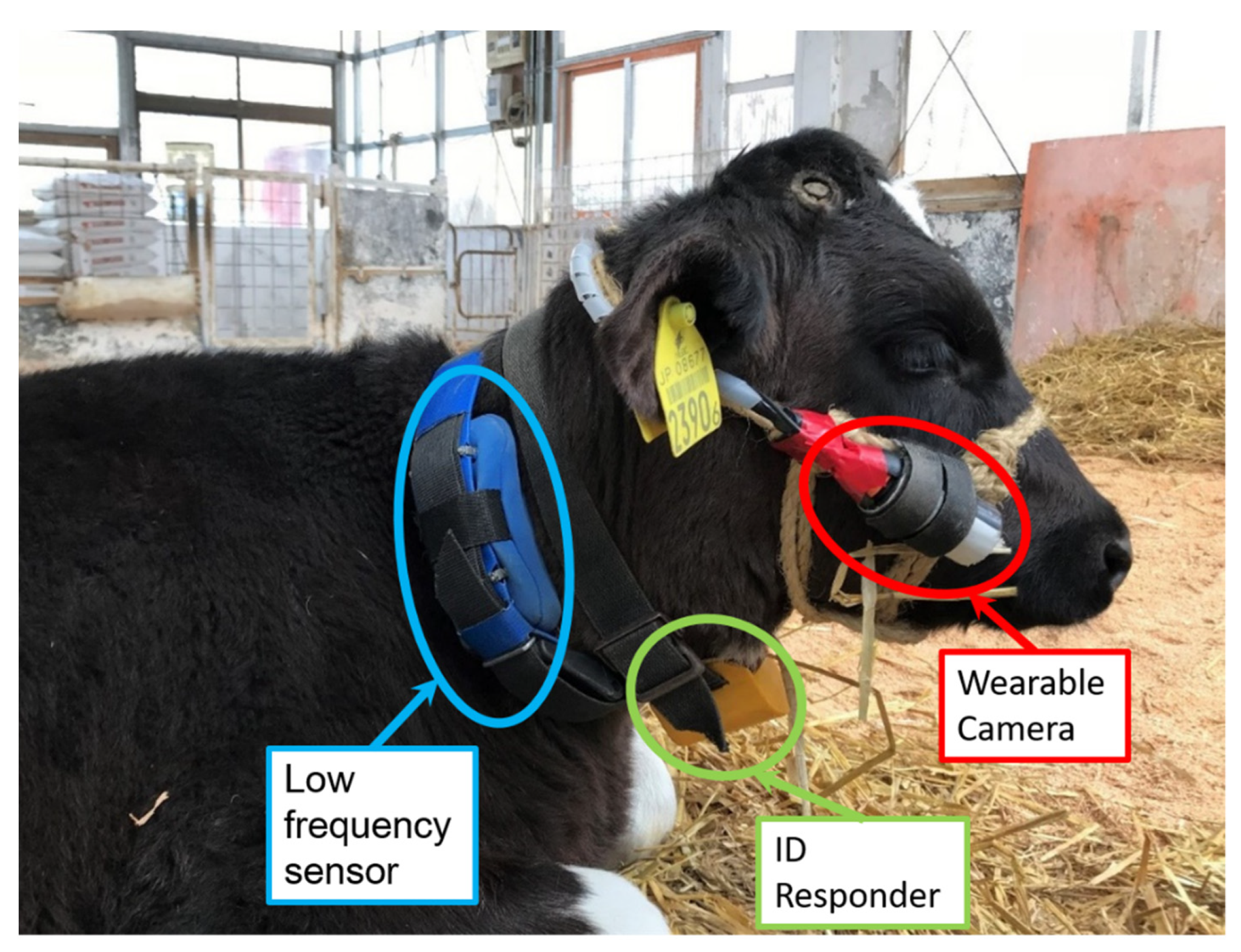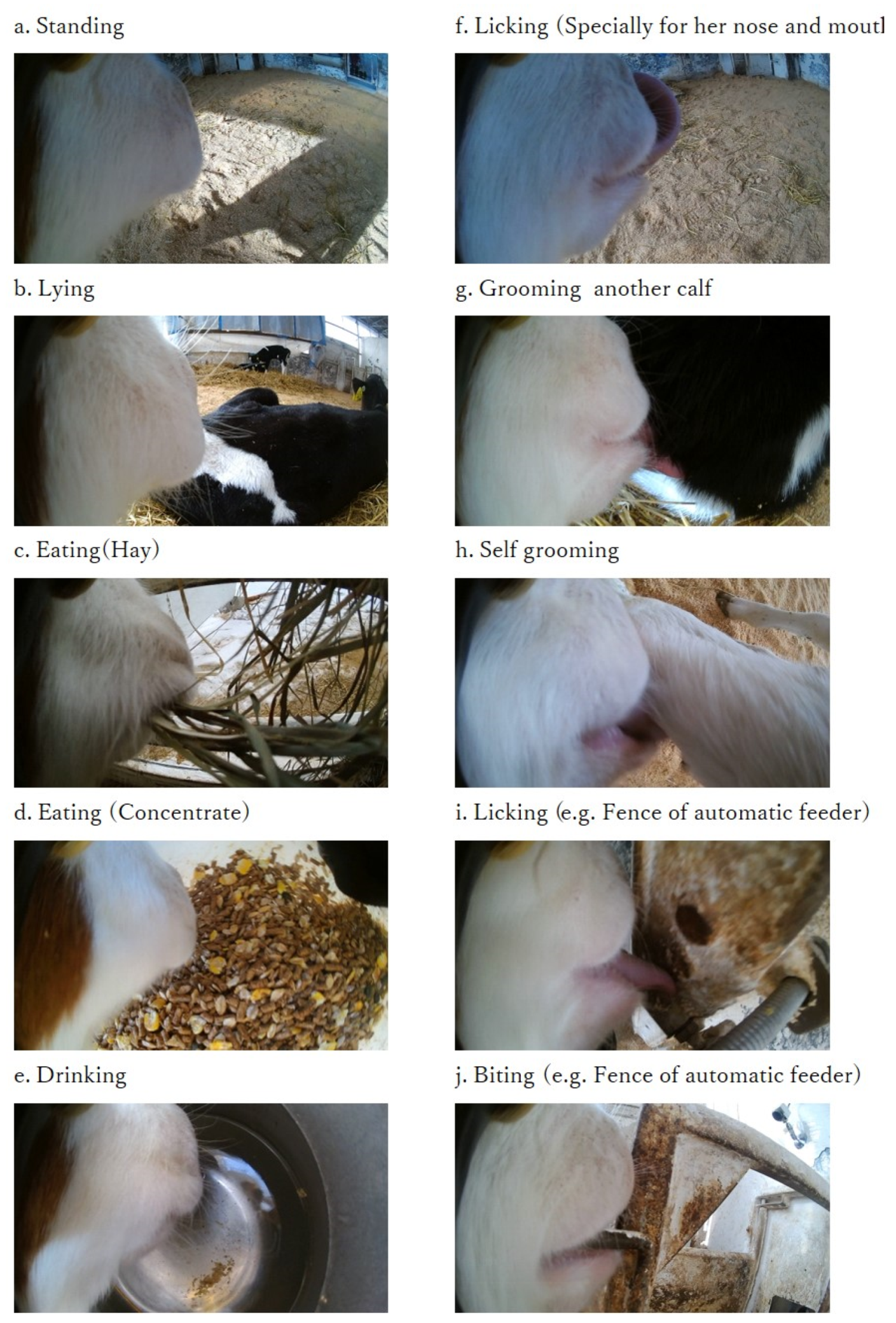Evaluation of Wearable Cameras for Monitoring and Analyzing Calf Behavior: A Preliminary Study
Abstract
:Simple Summary
Abstract
1. Introduction
2. Materials and Methods
2.1. Experimental Period and Location
2.2. Test Calves
2.3. Wearable Camera and Attachment
2.4. Behavioral Observations
2.5. Statistical Analysis
3. Results
3.1. Characteristics of Confirmed Behaviors
3.2. Comparison of Direct Observations and Observations of Images Obtained from a Wearable Camera
4. Discussion
5. Conclusions
Author Contributions
Funding
Institutional Review Board Statement
Informed Consent Statement
Acknowledgments
Conflicts of Interest
References
- Frost, A.R.; Schofield, C.P.; Beaulah, S.A.; Mottram, T.T.; Lines, J.A.; Wathes, C.M. A review of livestock monitoring and the need for integrated systems. Comput. Electron. Agric. 1997, 17, 139–159. [Google Scholar] [CrossRef]
- Tamura, T.; Okubo, Y.; Deguchi, Y.; Koshikawa, S.; Takahashi, M.; Chida, Y.; Okada, K. Dairy cattle behavior classifications based on decision tree learning using 3-axis neck-mounted accelerometers. Anim. Sci. J. 2019, 90, 589–596. [Google Scholar] [CrossRef] [PubMed]
- Tuyttens, F.A.M.; de Graaf, S.; Heerkens, J.L.; Jacobs, L.; Nalon, E.; Ott, S.; Stadig, L.; Van Laer, E.; Ampe, B. Observer bias in animal behaviour research: Can we believe what we score, if we score what we believe? Anim. Behav. 2014, 90, 273–280. [Google Scholar] [CrossRef]
- Bokkers, E.; de Vries, M.; Antonissen, I.; de Boer, I. Inter- and intra-observer reliability of experienced and inexperienced observers for the qualitative behaviour assessment in dairy cattle. Anim. Welfare 2012, 21, 307–318. [Google Scholar] [CrossRef]
- Richeson, J.T.; Lawrence, T.E.; White, B.J. Using advanced technologies to quantify beef cattle behavior. Transl. Anim. Sci. 2018, 2, 223–229. [Google Scholar] [CrossRef] [PubMed] [Green Version]
- Haley, D.B.; Rushen, J.; de Passillé, A.M. Behavioural indicators of cow comfort: Activity and resting behaviour of dairy cows in two types of housing. Can. J. Anim. Sci. 2000, 80, 257–263. [Google Scholar] [CrossRef]
- Lehrer, A.R.; Lewis, G.S.; Aizinbud, E. Oestrus detection in cattle: Recent developments. Anim. Reprod. Sci. 1992, 28, 355–362. [Google Scholar] [CrossRef]
- Rorie, R.W.; Bilby, T.R.; Lester, T.D. Application of electronic estrus detection technologies to reproductive management of cattle. Theriogenology 2002, 57, 137–148. [Google Scholar] [CrossRef]
- Kamphuis, C.; DelaRue, B.; Burke, C.R.; Jago, J. Field evaluation of two collar-mounted activity meters for detecting cows in estrus on a large pasture-grazed dairy farm. J. Dairy Sci. 2012, 95, 3045–3056. [Google Scholar] [CrossRef]
- Valenza, A.; Giordano, J.O.; Lopes, G.; Vincenti, L.; Amundson, M.C.; Fricke, P.M. Assessment of an accelerometer system for detection of estrus and treatment with gonadotropin-releasing hormone at the time of insemination in lactating dairy cows. J. Dairy Sci. 2012, 95, 7115–7127. [Google Scholar] [CrossRef]
- Silper, B.F.; Robles, I.; Madureira, A.M.L.; Burnett, T.A.; Reis, M.M.; de Passillé, A.M.; Rushen, J.; Cerri, R.L.A. Automated and visual measurements of estrous behavior and their sources of variation in Holstein heifers. I: Walking activity and behavior frequency. Theriogenology 2015, 84, 312–320. [Google Scholar] [CrossRef] [PubMed]
- Braun, U.; Trösch, L.; Nydegger, F.; Hässig, M. Evaluation of eating and rumination behaviour in cows using a noseband pressure sensor. BMC Vet. Res. 2013, 9, 164–171. [Google Scholar] [CrossRef] [PubMed] [Green Version]
- Zehner, N.; Umstätter, C.; Niederhauser, J.J.; Schick, M. System specification and validation of a noseband pressure sensor for measurement of ruminating and eating behavior in stable-fed cows. Comput. Electron. Agric. 2017, 136, 31–41. [Google Scholar] [CrossRef]
- Ruuska, S.; Kajava, S.; Mughal, M.; Zehner, N.; Mononen, J. Validation of a pressure sensor-based system for measuring eating, rumination and drinking behaviour of dairy cattle. Appl. Anim. Behav. Sci. 2016, 174, 19–23. [Google Scholar] [CrossRef]
- Hamilton, A.W.; Davison, C.; Tachtatzis, C.; Andonovic, I.; Michie, C.; Ferguson, H.J.; Somerville, L.; Jonsson, N.N. Identification of the rumination in cattle using support vector machines with motion-sensitive bolus sensors. Sensors 2019, 19, 1165. [Google Scholar] [CrossRef] [Green Version]
- Rutten, C.J.; Kamphuis, C.; Hogeveen, H.; Huijps, K.; Nielen, M.; Steeneveld, W. Sensor data on cow activity, rumination, and ear temperature improve prediction of the start of calving in dairy cows. Comput. Electron. Agric. 2017, 132, 108–118. [Google Scholar] [CrossRef]
- Sellier, N.; Guettier, E.; Staub, C. A review of methods to measure animal body temperature in precision farming. Am. J. Agric. Sci. Technol. 2014, 2, 74–99. [Google Scholar] [CrossRef]
- Nuffel, A.V.; Zwertvaegher, I.; Weyenberg, S.V.; Pastell, M.; Thorup, V.M.; Bahr, C.; Sonck, B.; Saeys, W. Lameness detection in dairy cows: Part 2. Use of sensors to automatically register changes in locomotion or behavior. Animals 2015, 5, 861–885. [Google Scholar] [CrossRef] [Green Version]
- Islam, M.A.; Lomax, S.; Doughty, A.K.; Islam, M.R.; Clark, C.E.F. Automated monitoring of panting for feedlot cattle: Sensor system accuracy and individual variability. Animals. 2020, 10, 1518. [Google Scholar] [CrossRef]
- Wolfger, B.; Timsit, E.; Pajor, E.A.; Cook, N.; Barkema, H.W.; Orsel, K. Technical note: Accuracy of an ear tag-attached accelerometer to monitor rumination and feeding behavior in feedlot cattle. J. Anim. Sci. 2015, 93, 3164–3168. [Google Scholar] [CrossRef] [Green Version]
- Pereira, G.M.; Heins, B.J.; Endres, M.I. Technical Note: Validation of an ear-tag accelerometer sensor to determine rumination, eating, and activity behaviors of grazing dairy cattle. J. Dairy Sci. 2018, 101, 2492–2495. [Google Scholar] [CrossRef] [Green Version]
- Swartz, T.H.; McGilliard, M.L.; Petersson-Wolfe, C.S. Technical note: The use of an accelerometer for measuring step activity and lying behaviors in dairy calves. Int. J. Dairy Sci. 2016, 99, 9109–9113. [Google Scholar] [CrossRef] [Green Version]
- Nadin, L.B.; Chopa, F.S.; Gibb, M.J.; da Trindade, J.K.; do Amaral, G.A.; de Faccio Carvalho, P.C.; Gonda, H.L. Comparison of methods to quantify the number of bites in calves grazing winter oats with different sward heights. Appl. Anim. Behav. Sci. 2012, 139, 50–57. [Google Scholar] [CrossRef]
- Nogami, H.; Okada, H.; Miyamoto, T.; Maeda, R.; Itoh, T. Wearable wireless temperature sensor nodes appressed to base of a calf’s tail. Sens. Mater. 2014, 26, 539–545. [Google Scholar] [CrossRef] [Green Version]
- Butler, S.; Thomson, P.; Lomax, S.; Clark, C. Optimizing calf rearing and weaning by monitoring the real-time development of rumination. Precis. Livest. Farm. 2017, 17, 122–127. [Google Scholar]
- Guo, Y.; He, D.; Chai, L. A machine vision-based method for monitoring scene-interactive behaviors of dairy calf. Animals 2020, 10, 190. [Google Scholar] [CrossRef] [PubMed] [Green Version]
- Eslamizad, M.; Tümmler, L.M.; Derno, M.; Hoch, M.; Kuhla, B. Technical note: Development of a pressure sensor-based system for measuring rumination time in pre-weaned dairy calves. J. Anim. Sci. 2018, 96, 4483–4489. [Google Scholar] [CrossRef] [PubMed]
- Heinrichs, A.J.; Jones, C.M.; Gray, S.M.; Heinrichs, P.A.; Cornelisse, S.A.; Goodling, R.C. identifying efficient dairy heifer producers using production costs and data envelopment analysis. J. Dairy Sci. 2013, 96, 7355–7362. [Google Scholar] [CrossRef] [Green Version]
- Yayota, M.; Doi, K. Continuous bite monitoring for grazing animals in a diverse pasture. Jpn. J. Grassl. Sci. 2018, 64, 119–124. (In Japanese) [Google Scholar] [CrossRef]
- Okuyama, J.; Nakajima, K.; Matsui, K.; Nakamura, Y.; Kondo, K.; Koizumi, T.; Arai, N. Application of a computer vision technique to animal-borne video data: Extraction of head movement to understand sea turtles’ visual assessment of surroundings. Anim. Biotelem. 2015, 3, 35. [Google Scholar] [CrossRef] [Green Version]
- Truong, B.T.; Venkatesh, S. Video abstraction: A systematic review and classification. ACM Trans. Multimed. Comput. Commun. Appl. 2017, 3, 3–12. [Google Scholar] [CrossRef]
- Watson, P.F.; Petrie, A. Method agreement analysis: A review of correct methodology. Theriogenology 2010, 73, 1167–1179. [Google Scholar] [CrossRef] [PubMed] [Green Version]
- Morita, S.; Sugita, S.; Yamamoto, M.; Hoshiba, S.; Uemura, T. Behavioral investigation of group rearing calves in automatic milk replacer feeding system. Nihon Chikusan Gakkaiho 1999, 70, 542–546. [Google Scholar] [CrossRef]




| Calf No. | Birth Date | Body Weight ※ (kg) | Weaning Date | Observation Date |
|---|---|---|---|---|
| 876 | 15 October 2017 | 86.4 | 23 December 2017 | 25 December 2017 |
| 877 | 18 October 2017 | 86.2 | 23 December 2017 | 22 December 2017 |
| 878 | 21 October 2017 | 84.8 | 25 December 2017 | 26 December 2017 |
| 879 | 27 October 2017 | 81.0 | 26 December 2017 | 27 December 2017 |
| Posture | Definition |
|---|---|
| Standing | Standing without moving legs. |
| Moving | Moving the leg, including taking one step (twitches in the leg or sliding on the floor). |
| Lying | Lying with the sternum in contact with the ground or flat on the side. |
| Behavior | Definition |
|---|---|
| Rumination | Displaying behaviors associated with rumination (e.g., regurgitating, chewing, and swallowing) |
| Feeding | Taking feed (hay or concentrate) in mouth, including chewing hay or concentrate beside hay rack or feed trough. For unweaned calf, milk feeding using an automatic feeder is included. |
| Others | Drinking, self-grooming, grooming another calf, licking, or biting objects. |
| Calf No. 876 | Direct Observation | |||
|---|---|---|---|---|
| Standing | Moving | Lying | ||
| Wearable camera | Standing | 94 | 1 | 3 |
| Moving | 4 | 5 | 0 | |
| Lying | 0 | 1 | 132 | |
| Calf No. 877 | Direct Observation | |||
| Standing | Moving | Lying | ||
| Wearable camera | Standing | 48 | 0 | 0 |
| Moving | 1 | 3 | 0 | |
| Lying | 0 | 0 | 188 | |
| Calf No. 878 | Direct Observation | |||
| Standing | Moving | Lying | ||
| Wearable camera | Standing | 62 | 0 | 1 |
| Moving | 0 | 6 | 0 | |
| Lying | 0 | 0 | 171 | |
| Calf No. 879 | Direct Observation | |||
| Standing | Moving | Lying | ||
| Wearable camera | Standing | 120 | 0 | 5 |
| Moving | 1 | 1 | 0 | |
| Lying | 1 | 0 | 112 | |
| Calf No. 876 | Direct Observation | |||
|---|---|---|---|---|
| Rumination | Eating | Others | ||
| Wearable camera | Rumination | 55 | 0 | 0 |
| Eating | 0 | 29 | 0 | |
| Others | 0 | 0 | 20 | |
| Calf No. 877 | Direct Observation | |||
| Rumination | Eating | Others | ||
| Wearable camera | Rumination | 20 | 0 | 0 |
| Eating | 0 | 33 | 0 | |
| Others | 0 | 0 | 18 | |
| Calf No. 878 | Direct Observation | |||
| Rumination | Eating | Others | ||
| Wearable camera | Rumination | 99 | 0 | 0 |
| Eating | 0 | 20 | 0 | |
| Others | 0 | 0 | 19 | |
| Calf No. 879 | Direct Observation | |||
| Rumination | Eating | Others | ||
| Wearable camera | Rumination | 30 | 0 | 0 |
| Eating | 0 | 13 | 0 | |
| Others | 0 | 0 | 31 | |
| Calf No. | Posture | Behavior |
|---|---|---|
| 876 | 0.93 *** | 1.00 *** |
| 877 | 0.99 *** | 1.00 *** |
| 878 | 0.99 *** | 1.00 *** |
| 879 | 0.94 *** | 1.00 *** |
| Direct Observation | Wearable Camera | Time (min) | Sum (min) |
|---|---|---|---|
| Standing | Moving | 3.0 | 7.5 |
| Moving | Standing | 4.5 | |
| Standing | Lying | 0.5 | 1.0 |
| Lying | Standing | 0.5 | |
| Moving | Lying | 0.5 | 0.5 |
Publisher’s Note: MDPI stays neutral with regard to jurisdictional claims in published maps and institutional affiliations. |
© 2021 by the authors. Licensee MDPI, Basel, Switzerland. This article is an open access article distributed under the terms and conditions of the Creative Commons Attribution (CC BY) license (https://creativecommons.org/licenses/by/4.0/).
Share and Cite
Saitoh, T.; Kato, Y. Evaluation of Wearable Cameras for Monitoring and Analyzing Calf Behavior: A Preliminary Study. Animals 2021, 11, 2622. https://doi.org/10.3390/ani11092622
Saitoh T, Kato Y. Evaluation of Wearable Cameras for Monitoring and Analyzing Calf Behavior: A Preliminary Study. Animals. 2021; 11(9):2622. https://doi.org/10.3390/ani11092622
Chicago/Turabian StyleSaitoh, Tomoko, and Yuko Kato. 2021. "Evaluation of Wearable Cameras for Monitoring and Analyzing Calf Behavior: A Preliminary Study" Animals 11, no. 9: 2622. https://doi.org/10.3390/ani11092622
APA StyleSaitoh, T., & Kato, Y. (2021). Evaluation of Wearable Cameras for Monitoring and Analyzing Calf Behavior: A Preliminary Study. Animals, 11(9), 2622. https://doi.org/10.3390/ani11092622





